MySQL进阶 - SQL性能优化
参考资料
插入数据
insert
普通插入:
create table tb_test(
id int comment'用户Id',
name varchar(50) not null comment '用户名'
) COMMENT='用户测试表';
insert into tb_test values(1,'tom');
insert into tb_test values(2,'cat');
insert into tb_test values(3,'jerry');
2
3
4
5
6
7
8
9
如果我们需要一次性往数据库表中插入多条记录,可以从以下三个方面进行优化。
- 采用批量插入(一次插入的数据不建议超过1000条)
insert into tb_test values(1,'Tom'),(2,'Cat'),(3,'Jerry');
- 手动提交事务
start transaction;
insert into tb_test values(1,'Tom'),(2,'Cat'),(3,'Jerry');
insert into tb_test values(4,'Tom'),(5,'Cat'),(6,'Jerry');
insert into tb_test values(7,'Tom'),(8,'Cat'),(9,'Jerry');
commit;
2
3
4
5
- 主键顺序插入
主键乱序插入 : 8 1 9 21 88 2 4 15 89 5 7 3
主键顺序插入 : 1 2 3 4 5 7 8 9 15 21 88 89
2
大批量插入数据
大批量插入: 如果一次性需要插入大批量数据,使用insert语句插入性能较低,此时可以使用MySQL数据库提供的load指令插入。
# 客户端连接服务端时,加上参数 --local-infile(这一行在bash/cmd界面输入)
mysql --local-infile -u root -p
# 设置全局参数local_infile为1,开启从本地加载文件导入数据的开关
set global local_infile = 1;
select @@local_infile;
# 执行load指令将准备好的数据,加载到表结构中
load data local infile '/root/load_user_100w_sort.sql' into table tb_user fields terminated by ',' lines terminated by '\n' ;
2
3
4
5
6
7
主键优化
数据组织方式:在InnoDB存储引擎中,表数据都是根据主键顺序组织存放的,这种存储方式的表称为索引组织表(Index organized table, IOT)
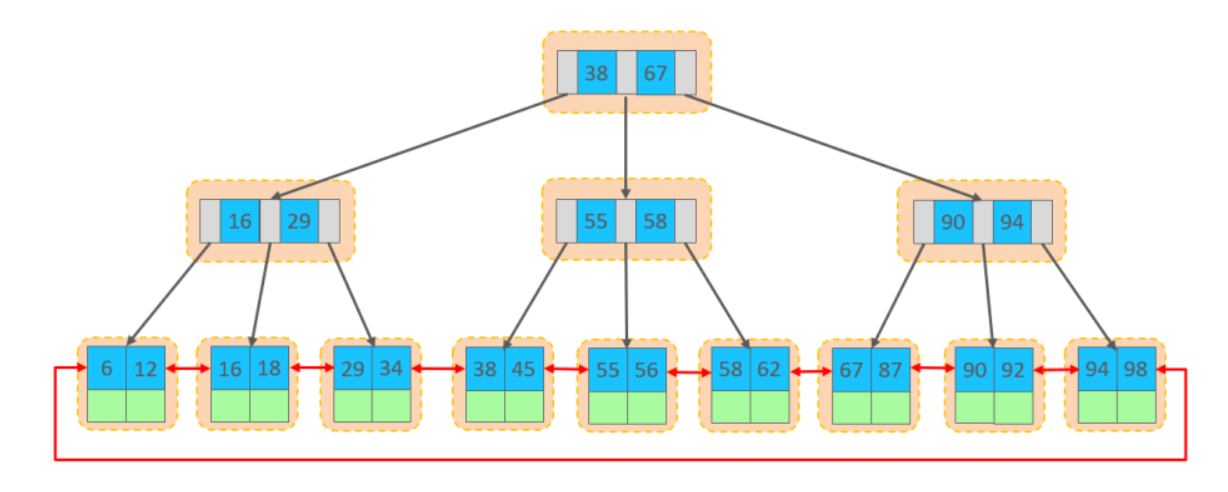
行数据,都是存储在聚集索引的叶子节点上的。InnoDB的逻辑结构图:
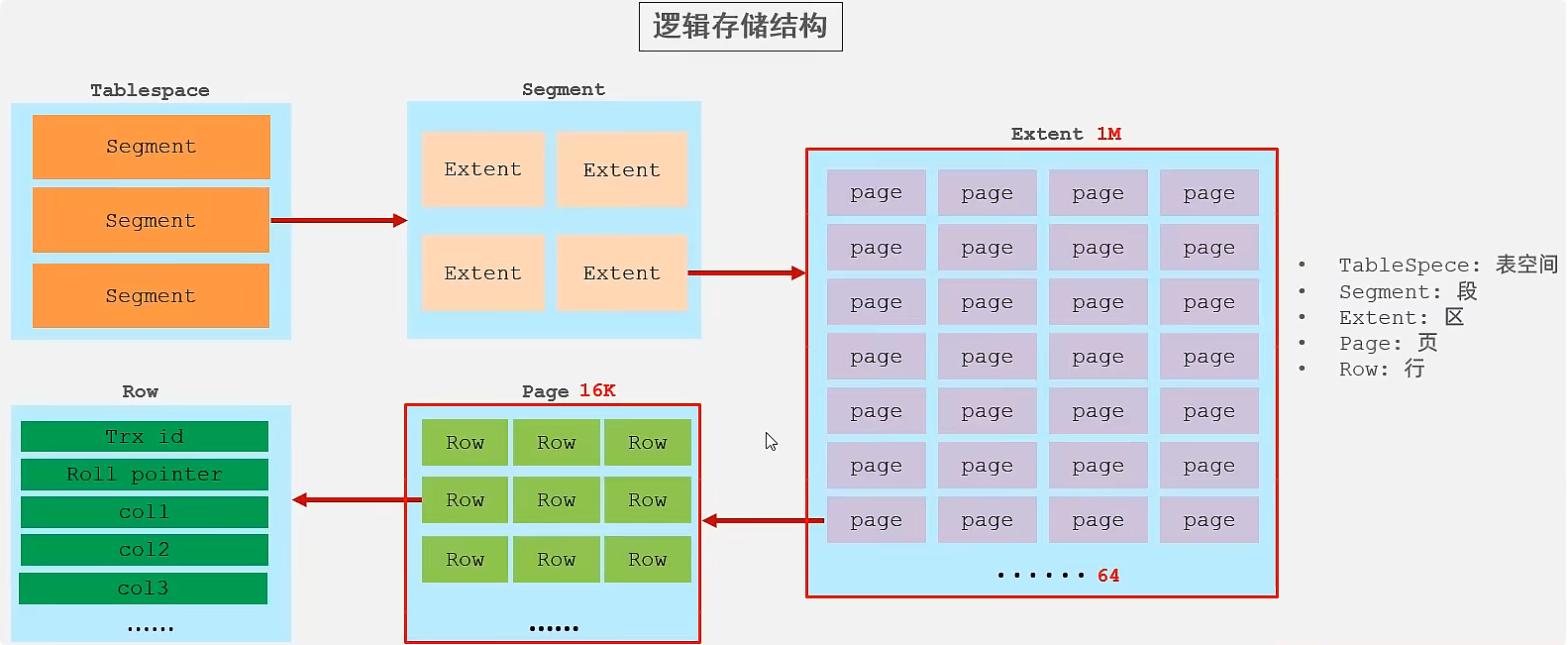
在InnoDB引擎中,数据行是记录在逻辑结构 page 页中的,而每一个页的大小是固定的,默认16K。那也就意味着, 一个页中所存储的行也是有限的,如果插入的数据行row在该页存储不小,将会存储到下一个页中,页与页之间会通过指针连接。
页分裂
页可以为空,也可以填充一般,也可以填充100%,每个页包含了2-N行数据(如果一行数据过大,会行溢出),根据主键排列。
主键顺序插入:
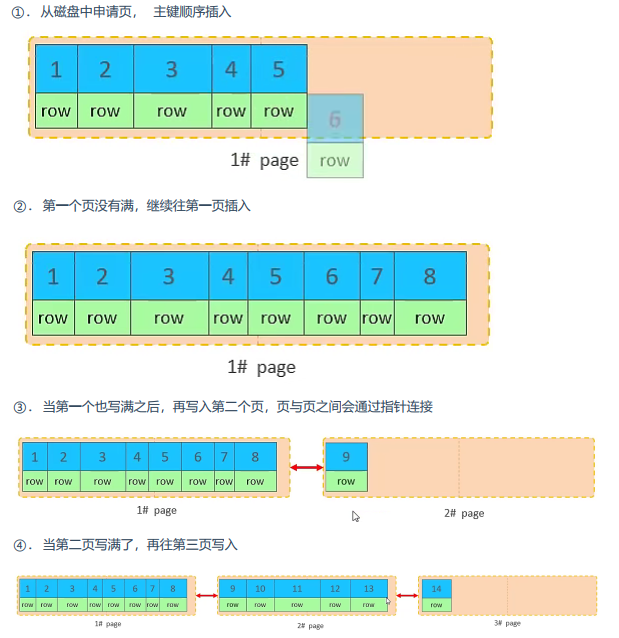
主键乱序插入:
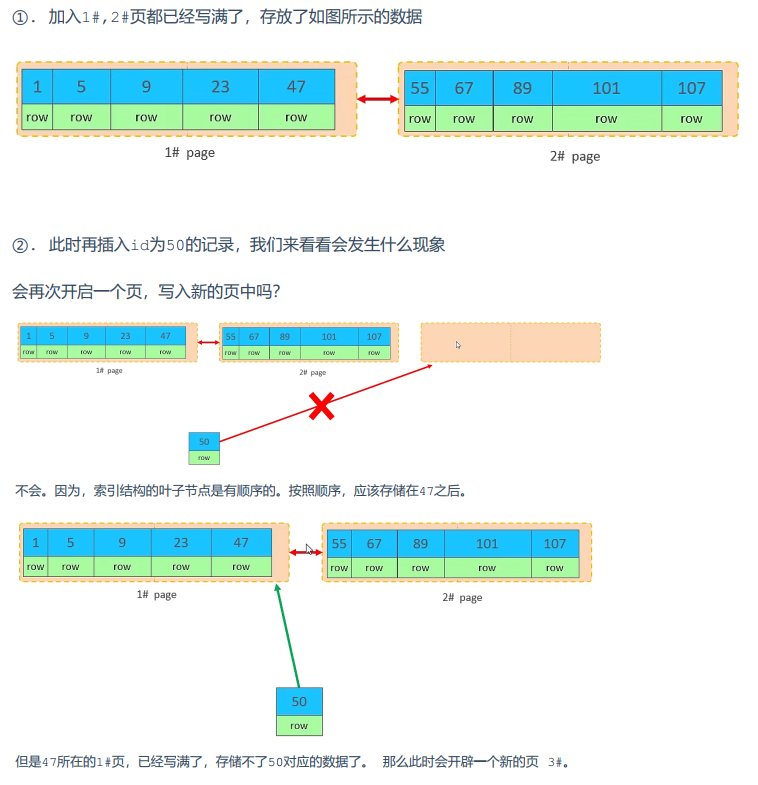

目前表中已有数据的索引结构(叶子节点)如下:
页合并
目前表中已有数据的索引结构(叶子节点)如下:

当删除一行记录时,实际上记录并没有被物理删除,只是记录被标记(flaged)为删除并且它的空间变得允许被其他记录声明使用。
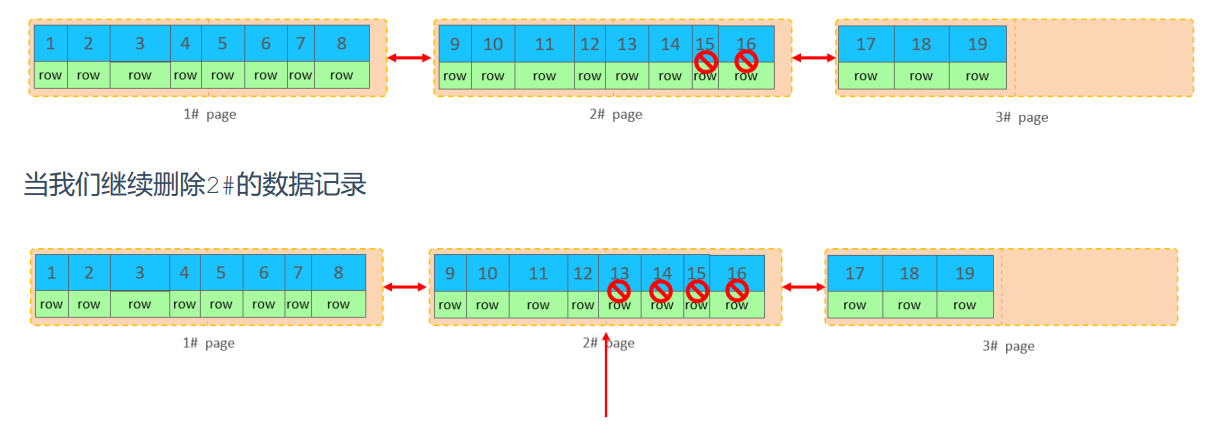
当页中删除的记录到达 MERGE_THRESHOLD(默认为页的50%),InnoDB会开始寻找最靠近的页(前后)看看是否可以将这两个页合并以优化空间使用。
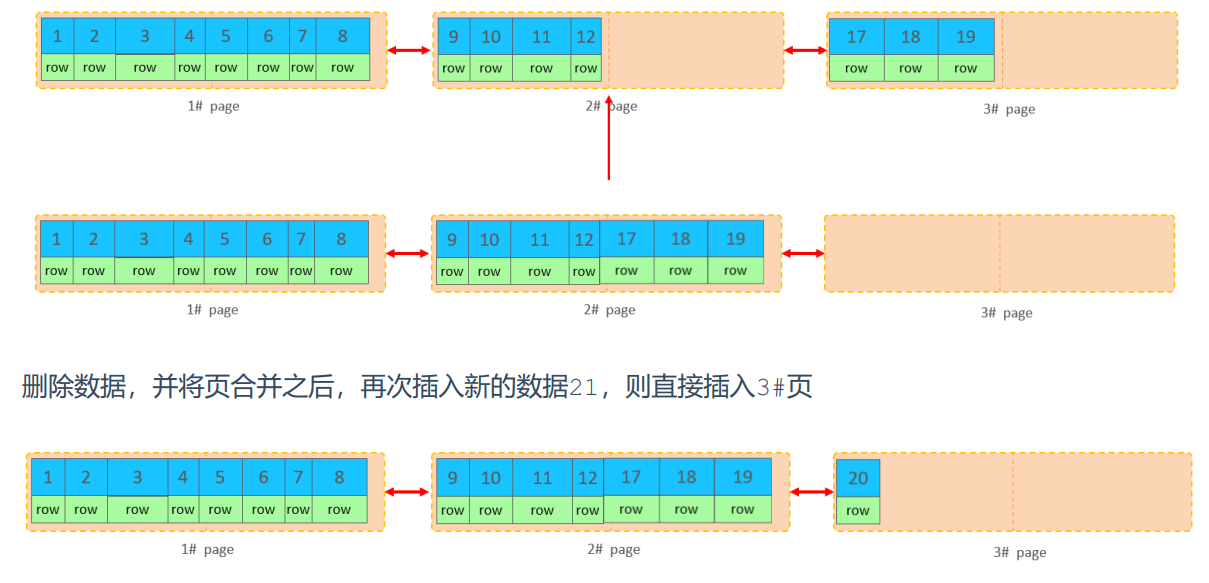
MERGE_THRESHOLD:合并页的阈值,可以自己设置,在创建表或创建索引时指定
索引设计原则
- 满足业务需求的情况下,尽量降低主键的长度
- 插入数据时,尽量选择顺序插入,选择使用 AUTO_INCREMENT 自增主键
- 尽量不要使用 UUID 做主键或者是其他的自然主键,如身份证号
- 业务操作时,避免对主键的修改
order by优化
MySQL的排序,有两种方式:
Using filesort:通过表的索引或全表扫描,读取满足条件的数据行,然后在排序缓冲区 sort buffer 中完成排序操作,所有不是通过索引直接返回排序结果的排序都叫 FileSort 排序
Using index:通过有序索引顺序扫描直接返回有序数据,这种情况即为 using index,不需要额外排序,操作效率高。
对于以上的两种排序方式,Using index的性能高,而Using filesort的性能低,我们在优化排序操作时,尽量要优化为 Using index。
示例:
-- A. 数据准备
mysql> show index from tb_user;
+---------+------------+----------+--------------+-------------+-----------+-------------+----------+--------+------+------------+---------+---------------+
| Table | Non_unique | Key_name | Seq_in_index | Column_name | Collation | Cardinality | Sub_part | Packed | Null | Index_type | Comment | Index_comment |
+---------+------------+----------+--------------+-------------+-----------+-------------+----------+--------+------+------------+---------+---------------+
| tb_user | 0 | PRIMARY | 1 | id | A | 24 | NULL | NULL | | BTREE | | |
+---------+------------+----------+--------------+-------------+-----------+-------------+----------+--------+------+------------+---------+---------------+
1 row in set (0.00 sec)
-- B. 执行排序SQL
mysql> explain select id,age,phone from tb_user order by age ;
+----+-------------+---------+------------+------+---------------+------+---------+------+------+----------+----------------+
| id | select_type | table | partitions | type | possible_keys | key | key_len | ref | rows | filtered | Extra |
+----+-------------+---------+------------+------+---------------+------+---------+------+------+----------+----------------+
| 1 | SIMPLE | tb_user | NULL | ALL | NULL | NULL | NULL | NULL | 24 | 100.00 | Using filesort |
+----+-------------+---------+------------+------+---------------+------+---------+------+------+----------+----------------+
1 row in set, 1 warning (0.00 sec)
mysql> explain select id,age,phone from tb_user order by age, phone ;
+----+-------------+---------+------------+------+---------------+------+---------+------+------+----------+----------------+
| id | select_type | table | partitions | type | possible_keys | key | key_len | ref | rows | filtered | Extra |
+----+-------------+---------+------------+------+---------------+------+---------+------+------+----------+----------------+
| 1 | SIMPLE | tb_user | NULL | ALL | NULL | NULL | NULL | NULL | 24 | 100.00 | Using filesort |
+----+-------------+---------+------------+------+---------------+------+---------+------+------+----------+----------------+
1 row in set, 1 warning (0.00 sec)
-- 由于 age, phone 都没有索引,所以此时再排序时,出现Using filesort,排序性能较低。
-- C. 创建索引
mysql> create index idx_user_age_phone_aa on tb_user(age,phone);
Query OK, 0 rows affected (0.05 sec)
Records: 0 Duplicates: 0 Warnings: 0
-- D. 创建索引后,根据age, phone进行升序排序
mysql> explain select id,age,phone from tb_user order by age ;
+----+-------------+---------+------------+-------+---------------+-----------------------+---------+------+------+----------+-------------+
| id | select_type | table | partitions | type | possible_keys | key | key_len | ref | rows | filtered | Extra |
+----+-------------+---------+------------+-------+---------------+-----------------------+---------+------+------+----------+-------------+
| 1 | SIMPLE | tb_user | NULL | index | NULL | idx_user_age_phone_aa | 37 | NULL | 24 | 100.00 | Using index |
+----+-------------+---------+------------+-------+---------------+-----------------------+---------+------+------+----------+-------------+
1 row in set, 1 warning (0.00 sec)
mysql> explain select id,age,phone from tb_user order by age, phone ;
+----+-------------+---------+------------+-------+---------------+-----------------------+---------+------+------+----------+-------------+
| id | select_type | table | partitions | type | possible_keys | key | key_len | ref | rows | filtered | Extra |
+----+-------------+---------+------------+-------+---------------+-----------------------+---------+------+------+----------+-------------+
| 1 | SIMPLE | tb_user | NULL | index | NULL | idx_user_age_phone_aa | 37 | NULL | 24 | 100.00 | Using index |
+----+-------------+---------+------------+-------+---------------+-----------------------+---------+------+------+----------+-------------+
1 row in set, 1 warning (0.00 sec)
-- 建立索引之后,再次进行排序查询,就由原来的Using filesort, 变为了 Using index,性能就是比较高的了。
-- E. 创建索引后,根据age, phone进行降序排序
mysql> explain select id,age,phone from tb_user order by age desc , phone desc ;
+----+-------------+---------+------------+-------+---------------+-----------------------+---------+------+------+----------+-------------+
| id | select_type | table | partitions | type | possible_keys | key | key_len | ref | rows | filtered | Extra |
+----+-------------+---------+------------+-------+---------------+-----------------------+---------+------+------+----------+-------------+
| 1 | SIMPLE | tb_user | NULL | index | NULL | idx_user_age_phone_aa | 37 | NULL | 24 | 100.00 | Backward index scan,Using index |
+----+-------------+---------+------------+-------+---------------+-----------------------+---------+------+------+----------+-------------+
1 row in set, 1 warning (0.00 sec)
-- 也出现 Using index, 但是此时Extra中出现了 Backward index scan,这个代表反向扫描索引,因为在MySQL中我们创建的索引,默认索引的叶子节点是从小到大排序的,而此时我们查询排序
-- 时,是从大到小,所以,在扫描时,就是反向扫描,就会出现 Backward index scan。
-- F. 根据phone,age进行升序排序,phone在前,age在后。
mysql> explain select id,age,phone from tb_user order by phone,age ;
+----+-------------+---------+------------+-------+---------------+-----------------------+---------+------+------+----------+-----------------------------+
| id | select_type | table | partitions | type | possible_keys | key | key_len | ref | rows | filtered | Extra |
+----+-------------+---------+------------+-------+---------------+-----------------------+---------+------+------+----------+-----------------------------+
| 1 | SIMPLE | tb_user | NULL | index | NULL | idx_user_age_phone_aa | 37 | NULL | 24 | 100.00 | Using index; Using filesort |
+----+-------------+---------+------------+-------+---------------+-----------------------+---------+------+------+----------+-----------------------------+
1 row in set, 1 warning (0.00 sec)
-- 排序时,也需要满足最左前缀法则,否则也会出现 filesort。因为在创建索引的时候, age是第一个字段,phone是第二个字段,所以排序时,也就该按照这个顺序来,否则就会出现 Using filesort。
-- G. 根据age, phone进行降序一个升序,一个降序
mysql> explain select id,age,phone from tb_user order by age asc , phone desc ;
+----+-------------+---------+------------+-------+---------------+-----------------------+---------+------+------+----------+-----------------------------+
| id | select_type | table | partitions | type | possible_keys | key | key_len | ref | rows | filtered | Extra |
+----+-------------+---------+------------+-------+---------------+-----------------------+---------+------+------+----------+-----------------------------+
| 1 | SIMPLE | tb_user | NULL | index | NULL | idx_user_age_phone_aa | 37 | NULL | 24 | 100.00 | Using index; Using filesort |
+----+-------------+---------+------------+-------+---------------+-----------------------+---------+------+------+----------+-----------------------------+
1 row in set, 1 warning (0.00 sec)
-- 因为创建索引时,如果未指定顺序,默认都是按照升序排序的,而查询时,一个升序,一个降序,此时就会出现Using filesort。
-- 为了解决上述的问题,我们可以创建一个索引,这个联合索引中 age 升序排序,phone 倒序排序。
-- H. 创建联合索引(age 升序排序,phone 倒序排序)
mysql> create index idx_user_age_phone_ad on tb_user(age asc ,phone desc);
Query OK, 0 rows affected, 1 warning (0.04 sec)
Records: 0 Duplicates: 0 Warnings: 1
mysql> show index from tb_user;
+---------+------------+-----------------------+--------------+-------------+-----------+-------------+----------+--------+------+------------+---------+---------------+
| Table | Non_unique | Key_name | Seq_in_index | Column_name | Collation | Cardinality | Sub_part | Packed | Null | Index_type | Comment | Index_comment |
+---------+------------+-----------------------+--------------+-------------+-----------+-------------+----------+--------+------+------------+---------+---------------+
| tb_user | 0 | PRIMARY | 1 | id | A | 24 | NULL | NULL | | BTREE | | |
| tb_user | 1 | idx_user_age_phone_aa | 1 | age | A | 19 | NULL | NULL | YES | BTREE | | |
| tb_user | 1 | idx_user_age_phone_aa | 2 | phone | A | 24 | NULL | NULL | | BTREE | | |
| tb_user | 1 | idx_user_age_phone_ad | 1 | age | A | 19 | NULL | NULL | YES | BTREE | | |
| tb_user | 1 | idx_user_age_phone_ad | 2 | phone | D | 24 | NULL | NULL | | BTREE | | |
+---------+------------+-----------------------+--------------+-------------+-----------+-------------+----------+--------+------+------------+---------+---------------+
5 rows in set (0.00 sec)
-- I. 然后再次执行如下SQL
mysql> explain select id,age,phone from tb_user order by age asc , phone desc ;
+----+-------------+---------+------------+-------+---------------+-----------------------+---------+------+------+----------+-------------+
| id | select_type | table | partitions | type | possible_keys | key | key_len | ref | rows | filtered | Extra |
+----+-------------+---------+------------+-------+---------------+-----------------------+---------+------+------+----------+-------------+
| 1 | SIMPLE | tb_user | NULL | index | NULL | idx_user_age_phone_aa | 37 | NULL | 24 | 100.00 | Using index |
+----+-------------+---------+------------+-------+---------------+-----------------------+---------+------+------+----------+-------------+
1 row in set, 1 warning (0.00 sec)
2
3
4
5
6
7
8
9
10
11
12
13
14
15
16
17
18
19
20
21
22
23
24
25
26
27
28
29
30
31
32
33
34
35
36
37
38
39
40
41
42
43
44
45
46
47
48
49
50
51
52
53
54
55
56
57
58
59
60
61
62
63
64
65
66
67
68
69
70
71
72
73
74
75
76
77
78
79
80
81
82
83
84
85
86
87
88
89
90
91
92
93
94
95
96
97
98
99
100
101
102
103
104
105
106
107
108
109
110
111
112
113
114
115
注意事项:降序索引,MySQL版本可能要8.0以上
总结:
- 根据排序字段建立合适的索引,多字段排序时,也遵循最左前缀法则
- 尽量使用覆盖索引
- 多字段排序,一个升序一个降序,此时需要注意联合索引在创建时的规则(ASC/DESC)
- 如果不可避免出现filesort,大数据量排序时,可以适当增大排序缓冲区大小 sort_buffer_size(默认256k)
group by优化
-- A. 数据准备,删除其他索引
mysql> show index from tb_user;
+---------+------------+----------+--------------+-------------+-----------+-------------+----------+--------+------+------------+---------+---------------+
| Table | Non_unique | Key_name | Seq_in_index | Column_name | Collation | Cardinality | Sub_part | Packed | Null | Index_type | Comment | Index_comment |
+---------+------------+----------+--------------+-------------+-----------+-------------+----------+--------+------+------------+---------+---------------+
| tb_user | 0 | PRIMARY | 1 | id | A | 24 | NULL | NULL | | BTREE | | |
+---------+------------+----------+--------------+-------------+-----------+-------------+----------+--------+------+------------+---------+---------------+
1 row in set (0.00 sec)
-- A. 在没有索引的情况下,执行如下SQL,查询执行计划
mysql> explain select profession , count(*) from tb_user group by profession ;
+----+-------------+---------+------------+------+---------------+------+---------+------+------+----------+---------------------------------+
| id | select_type | table | partitions | type | possible_keys | key | key_len | ref | rows | filtered | Extra |
+----+-------------+---------+------------+------+---------------+------+---------+------+------+----------+---------------------------------+
| 1 | SIMPLE | tb_user | NULL | ALL | NULL | NULL | NULL | NULL | 24 | 100.00 | Using temporary; Using filesort |
+----+-------------+---------+------------+------+---------------+------+---------+------+------+----------+---------------------------------+
1 row in set, 1 warning (0.00 sec)
-- B. 针对于 profession , age, status 创建一个联合索引
mysql> create index idx_user_pro_age_sta on tb_user(profession , age , status);
Query OK, 0 rows affected (0.04 sec)
Records: 0 Duplicates: 0 Warnings: 0
mysql> explain select profession , count(*) from tb_user group by profession ;
+----+-------------+---------+------------+-------+----------------------+----------------------+---------+------+------+----------+-------------+
| id | select_type | table | partitions | type | possible_keys | key | key_len | ref | rows | filtered | Extra |
+----+-------------+---------+------------+-------+----------------------+----------------------+---------+------+------+----------+-------------+
| 1 | SIMPLE | tb_user | NULL | index | idx_user_pro_age_sta | idx_user_pro_age_sta | 42 | NULL | 24 | 100.00 | Using index |
+----+-------------+---------+------------+-------+----------------------+----------------------+---------+------+------+----------+-------------+
1 row in set, 1 warning (0.00 sec)
mysql> explain select profession , count(*) from tb_user group by profession,age;
+----+-------------+---------+------------+-------+----------------------+----------------------+---------+------+------+----------+-------------+
| id | select_type | table | partitions | type | possible_keys | key | key_len | ref | rows | filtered | Extra |
+----+-------------+---------+------------+-------+----------------------+----------------------+---------+------+------+----------+-------------+
| 1 | SIMPLE | tb_user | NULL | index | idx_user_pro_age_sta | idx_user_pro_age_sta | 42 | NULL | 24 | 100.00 | Using index |
+----+-------------+---------+------------+-------+----------------------+----------------------+---------+------+------+----------+-------------+
1 row in set, 1 warning (0.00 sec)
mysql> explain select age , count(*) from tb_user group by age;
+----+-------------+---------+------------+-------+----------------------+----------------------+---------+------+------+----------+----------------------------------------------+
| id | select_type | table | partitions | type | possible_keys | key | key_len | ref | rows | filtered | Extra |
+----+-------------+---------+------------+-------+----------------------+----------------------+---------+------+------+----------+----------------------------------------------+
| 1 | SIMPLE | tb_user | NULL | index | idx_user_pro_age_sta | idx_user_pro_age_sta | 42 | NULL | 24 | 100.00 | Using index; Using temporary; Using filesort |
+----+-------------+---------+------------+-------+----------------------+----------------------+---------+------+------+----------+----------------------------------------------+
1 row in set, 1 warning (0.00 sec)
-- 发现,如果仅仅根据age分组,就会出现 Using temporary ;而如果是 根据profession,age两个字段同时分组,则不会出现 Using temporary。原因是因为对于分组操作,
-- 在联合索引中,也是符合最左前缀法则的。2
3
4
5
6
7
8
9
10
11
12
13
14
15
16
17
18
19
20
21
22
23
24
25
26
27
28
29
30
31
32
33
34
35
36
37
38
39
40
41
42
43
44
45
46
47
48
- 在分组操作时,可以通过索引来提高效率
- 分组操作时,索引的使用也是满足最左前缀法则的
如索引为idx_user_pro_age_stat,则句式可以是select ... where profession order by age,这样也符合最左前缀法则
limit优化
在数据量比较大时,如果进行limit分页查询,在查询时,越往后,分页查询效率越低。
一起来看看执行limit分页查询耗时对比:
mysql> select count(*) from big_data;
+----------+
| count(*) |
+----------+
| 10000000 |
+----------+
1 row in set (2.49 sec)
mysql> select * from big_data limit 0,10;
+----+-------+------+---------------+
| id | name | age | email |
+----+-------+------+---------------+
| 1 | test0 | 37 | test0@163.com |
| 2 | test1 | 45 | test1@163.com |
| 3 | test2 | 13 | test2@163.com |
| 4 | test3 | 30 | test3@163.com |
| 5 | test4 | 12 | test4@163.com |
| 6 | test5 | 21 | test5@163.com |
| 7 | test6 | 17 | test6@163.com |
| 8 | test7 | 23 | test7@163.com |
| 9 | test8 | 15 | test8@163.com |
| 10 | test9 | 3 | test9@163.com |
+----+-------+------+---------------+
10 rows in set (0.02 sec)
mysql> select * from big_data limit 1000000,10;
+---------+-------------+------+---------------------+
| id | name | age | email |
+---------+-------------+------+---------------------+
| 1000001 | test1000000 | 4 | test1000000@163.com |
| 1000002 | test1000001 | 27 | test1000001@163.com |
| 1000003 | test1000002 | 23 | test1000002@163.com |
| 1000004 | test1000003 | 33 | test1000003@163.com |
| 1000005 | test1000004 | 47 | test1000004@163.com |
| 1000006 | test1000005 | 35 | test1000005@163.com |
| 1000007 | test1000006 | 33 | test1000006@163.com |
| 1000008 | test1000007 | 9 | test1000007@163.com |
| 1000009 | test1000008 | 49 | test1000008@163.com |
| 1000010 | test1000009 | 18 | test1000009@163.com |
+---------+-------------+------+---------------------+
10 rows in set (0.45 sec)
mysql> select * from big_data limit 5000000,10;
+---------+-------------+------+---------------------+
| id | name | age | email |
+---------+-------------+------+---------------------+
| 5000001 | test5000000 | 47 | test5000000@163.com |
| 5000002 | test5000001 | 50 | test5000001@163.com |
| 5000003 | test5000002 | 7 | test5000002@163.com |
| 5000004 | test5000003 | 36 | test5000003@163.com |
| 5000005 | test5000004 | 10 | test5000004@163.com |
| 5000006 | test5000005 | 43 | test5000005@163.com |
| 5000007 | test5000006 | 36 | test5000006@163.com |
| 5000008 | test5000007 | 48 | test5000007@163.com |
| 5000009 | test5000008 | 31 | test5000008@163.com |
| 5000010 | test5000009 | 13 | test5000009@163.com |
+---------+-------------+------+---------------------+
10 rows in set (2.36 sec)
mysql> select * from big_data limit 9000000,10;
+---------+-------------+------+---------------------+
| id | name | age | email |
+---------+-------------+------+---------------------+
| 9000001 | test9000000 | 2 | test9000000@163.com |
| 9000002 | test9000001 | 12 | test9000001@163.com |
| 9000003 | test9000002 | 3 | test9000002@163.com |
| 9000004 | test9000003 | 30 | test9000003@163.com |
| 9000005 | test9000004 | 43 | test9000004@163.com |
| 9000006 | test9000005 | 22 | test9000005@163.com |
| 9000007 | test9000006 | 33 | test9000006@163.com |
| 9000008 | test9000007 | 48 | test9000007@163.com |
| 9000009 | test9000008 | 42 | test9000008@163.com |
| 9000010 | test9000009 | 15 | test9000009@163.com |
+---------+-------------+------+---------------------+
10 rows in set (3.77 sec)
2
3
4
5
6
7
8
9
10
11
12
13
14
15
16
17
18
19
20
21
22
23
24
25
26
27
28
29
30
31
32
33
34
35
36
37
38
39
40
41
42
43
44
45
46
47
48
49
50
51
52
53
54
55
56
57
58
59
60
61
62
63
64
65
66
67
68
69
70
71
72
73
74
75
通过测试发现越往后,分页查询效率越低,这就是分页查询的问题所在。
因为,当在进行分页查询时,如果执行 limit 2000000,10 ,此时需要MySQL排序前2000010 记录,仅仅返回 2000000 - 2000010 的记录,其他记录丢弃,查询排序的代价非常大 。
优化方案:一般分页查询时,通过创建覆盖索引能够比较好地提高性能,可以通过覆盖索引加子查询形式进行优化
例如:
-- 此语句耗时很长
mysql> select * from big_data limit 9000000,10;
+---------+-------------+------+---------------------+
| id | name | age | email |
+---------+-------------+------+---------------------+
| 9000001 | test9000000 | 2 | test9000000@163.com |
| 9000002 | test9000001 | 12 | test9000001@163.com |
| 9000003 | test9000002 | 3 | test9000002@163.com |
| 9000004 | test9000003 | 30 | test9000003@163.com |
| 9000005 | test9000004 | 43 | test9000004@163.com |
| 9000006 | test9000005 | 22 | test9000005@163.com |
| 9000007 | test9000006 | 33 | test9000006@163.com |
| 9000008 | test9000007 | 48 | test9000007@163.com |
| 9000009 | test9000008 | 42 | test9000008@163.com |
| 9000010 | test9000009 | 15 | test9000009@163.com |
+---------+-------------+------+---------------------+
10 rows in set (3.20 sec)
-- 通过覆盖索引加快速度,直接通过主键索引进行排序及查询
mysql> select id from big_data order by id limit 9000000, 10;
+---------+
| id |
+---------+
| 9000001 |
| 9000002 |
| 9000003 |
| 9000004 |
| 9000005 |
| 9000006 |
| 9000007 |
| 9000008 |
| 9000009 |
| 9000010 |
+---------+
10 rows in set (2.18 sec)
-- 通过连表查询即可实现第一句的效果,并且能达到第二句的速度
mysql> select s.* from big_data as s, (select id from big_data order by id limit 9000000, 10) as a where s.id = a.id;
+---------+-------------+------+---------------------+
| id | name | age | email |
+---------+-------------+------+---------------------+
| 9000001 | test9000000 | 2 | test9000000@163.com |
| 9000002 | test9000001 | 12 | test9000001@163.com |
| 9000003 | test9000002 | 3 | test9000002@163.com |
| 9000004 | test9000003 | 30 | test9000003@163.com |
| 9000005 | test9000004 | 43 | test9000004@163.com |
| 9000006 | test9000005 | 22 | test9000005@163.com |
| 9000007 | test9000006 | 33 | test9000006@163.com |
| 9000008 | test9000007 | 48 | test9000007@163.com |
| 9000009 | test9000008 | 42 | test9000008@163.com |
| 9000010 | test9000009 | 15 | test9000009@163.com |
+---------+-------------+------+---------------------+
10 rows in set (2.43 sec)
2
3
4
5
6
7
8
9
10
11
12
13
14
15
16
17
18
19
20
21
22
23
24
25
26
27
28
29
30
31
32
33
34
35
36
37
38
39
40
41
42
43
44
45
46
47
48
49
50
51
52
53
count优化
在之前的测试中,我们发现,如果数据量很大,在执行count操作时,是非常耗时的。
- MyISAM 引擎把一个表的总行数存在了磁盘上,因此执行 count(*) 的时候会直接返回这个数,效率很高(前提是不适用where);
- InnoDB 在执行 count(*) 时,需要把数据一行一行地从引擎里面读出来,然后累计计数。
要大幅度提升InnoDB表的count效率,主要的优化思路:自己计数,如创建key-value表存储在内存或硬盘,或者是用redis
count的几种用法
count() 是一个聚合函数,对于返回的结果集,一行行地判断,如果 count 函数的参数不是NULL,累计值就加 1,否则不加,最后返回累计值。
用法:count(*)、count(主键)、count(字段)、count(数字)
各种用法的性能:
- count(主键):InnoDB引擎会遍历整张表,把每行的主键id值都取出来,返回给服务层,服务层拿到主键后,直接按行进行累加(主键不可能为空)
- count(字段):没有not null约束的话,InnoDB引擎会遍历整张表把每一行的字段值都取出来,返回给服务层,服务层判断是否为null,不为null,计数累加;有not null约束的话,InnoDB引擎会遍历整张表把每一行的字段值都取出来,返回给服务层,直接按行进行累加
- count(1):InnoDB 引擎遍历整张表,但不取值。服务层对于返回的每一层,放一个数字 1 进去,直接按行进行累加
- count(*):InnoDB 引擎并不会把全部字段取出来,而是专门做了优化,不取值,服务层直接按行进行累加
按效率排序:count(字段) < count(主键) < count(1) < count(),所以尽量使用 count()
update优化(避免行锁升级为表锁)
InnoDB 的行锁是针对索引加的锁,不是针对记录加的锁,并且该索引不能失效,否则会从行锁升级为表锁。
如以下两条语句:
update course set name = 'javaEE' where id = 1;,
这句由于id有主键索引,所以只会锁这一行;
update course set name = 'SpringBoot' where name = 'PHP' ;
这句由于name没有索引,所以会把整张表都锁住进行数据更新,解决方法是给name字段添加索引
优化数据访问
减少请求的数据量
- 只返回必要的列:最好不要使用 SELECT * 语句。
- 只返回必要的行:使用 LIMIT 语句来限制返回的数据。
- 缓存重复查询的数据:使用缓存可以避免在数据库中进行查询,特别在要查询的数据经常被重复查询时,缓存带来的查询性能提升将会是非常明显的。
减少服务器端扫描的行数
最有效的方式是使用索引来覆盖查询。
重构查询方式
切分大查询
一个大查询如果一次性执行的话,可能一次锁住很多数据、占满整个事务日志、耗尽系统资源、阻塞很多小的但重要的查询。
DELEFT FROM messages WHERE create < DATE_SUB(NOW(), INTERVAL 3 MONTH);
rows_affected = 0
do {
rows_affected = do_query(
"DELETE FROM messages WHERE create < DATE_SUB(NOW(), INTERVAL 3 MONTH) LIMIT 10000")
} while rows_affected > 0
2
3
4
5
分解大连接查询
将一个大连接查询分解成对每一个表进行一次单表查询,然后将结果在应用程序中进行关联,这样做的好处有:
- 让缓存更高效。对于连接查询,如果其中一个表发生变化,那么整个查询缓存就无法使用。而分解后的多个查询,即使其中一个表发生变化,对其它表的查询缓存依然可以使用。
- 分解成多个单表查询,这些单表查询的缓存结果更可能被其它查询使用到,从而减少冗余记录的查询。
- 减少锁竞争;
- 在应用层进行连接,可以更容易对数据库进行拆分,从而更容易做到高性能和可伸缩。
- 查询本身效率也可能会有所提升。例如下面的例子中,使用 IN() 代替连接查询,可以让 MySQL 按照 ID 顺序进行查询,这可能比随机的连接要更高效。
SELECT * FROM tab
JOIN tag_post ON tag_post.tag_id=tag.id
JOIN post ON tag_post.post_id=post.id
WHERE tag.tag='mysql';
2
3
4
SELECT * FROM tag WHERE tag='mysql';
SELECT * FROM tag_post WHERE tag_id=1234;
SELECT * FROM post WHERE post.id IN (123,456,567,9098,8904);
2
3
补充:
数据库怎么优化查询效率?
- 存储引擎选择:如果数据表需要事务处理,应该考虑使用 InnoDB,因为它完全符合 ACID 特性。如果不需要事务处理,使用 MyISAM 是比较好。
- 分表分库,主从架构。
- 对查询进行优化,要尽量避免全表扫描,首先应考虑在 where 及 order by 涉及的列上建立索引
- 应尽量避免在 where 子句中对字段进行 null 值判断,否则将导致引擎放弃使用索引而进行全表扫描
- 应尽量避免在 where 子句中使用 != 或 <> 操作符,否则将引擎放弃使用索引而进行全表扫描
- 应尽量避免在 where 子句中使用 or 来连接条件,如果一个字段有索引,一个字段没有索引,将导致引擎放弃使用索引而进行全表扫描
- Update 语句,如果只更改 1、2 个字段,不要 Update 全部字段,否则频繁调用会引起明显的性能消耗,同时带来大量日志
- 对于多张大数据量(这里几百条就算大了)的表 JOIN,要先分页再 JOIN,否则逻辑读会很高,性能很差。